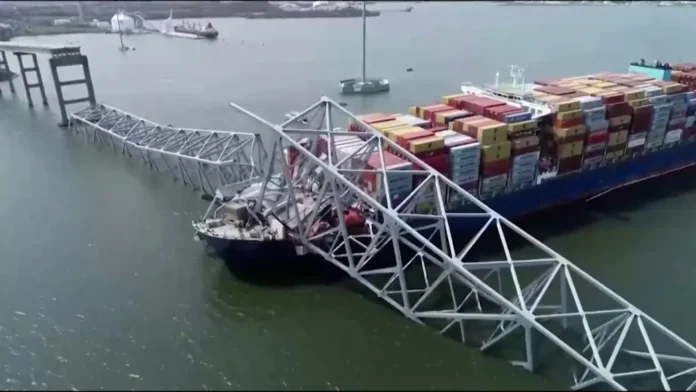New audio recordings have shed light on the frantic efforts by the crew of a cargo ship to avoid catastrophe in the minutes before it struck the Francis Scott Key Bridge in Baltimore, causing the critical East Coast shipping artery to collapse into the Patapsco River.
The recordings, retrieved from the voyage data recorder of the 984-foot Singapore-flagged vessel Dali, capture alarms blaring, steering orders shouted, and the increasingly urgent pleas for assistance as the powerless ship drifted perilously close to the bridge early Tuesday morning.
In a news conference on Wednesday, Marcel Muise, an investigator with the National Transportation Safety Board, walked through the audio timeline that federal officials say shows the intense moments leading up to the disaster at around 1:27 a.m. on March 28th.
The first warning signs came just before 1:25 a.m., when a series of alarms can be heard going off on the Dali’s bridge. About a minute later, the audio picks up steering commands and rudder instructions as the crew appeared to realize something was wrong and tried to maneuver the massive ship.
At 1:26:39 a.m., with likely only moments before impact, the pilot made an urgent radio call for any available tug boats in the area to provide emergency assistance. Just 45 seconds later, he ordered the dropping of the ship’s port anchor – a final desperate measure to try and stop the vessel’s momentum.
But by 1:27:25 a.m., the pilot’s voice can be heard clearly saying the Dali had lost all power and was headed directly for the bridge. Around the same time, an officer with the Maryland Transportation Authority monitoring the overnight road work on the span ordered the immediate closure of the bridge to traffic, undoubtedly saving lives.
The audio recording then picks up what investigators describe as “sounds consistent with the collision” at 1:29:33 a.m., as the powerless 80,000 ton ship struck the bridge at an estimated speed of 8 mph. Just six seconds later, the shaken pilot can be heard reporting to the Coast Guard that the bridge had collapsed.
Jennifer Homendy, chair of the NTSB, cautioned that while voyage data recorders provide vital clues, they offer only a “snapshot” compared to the wealth of information captured by aircraft black boxes. She said her agency has long pushed for enhanced data recording requirements for ships.
The new audio details seem to align with the timeline previously released by the Unified Command response group overseeing the investigation and recovery efforts. On Thursday, they had announced a temporary pause in dive operations due to hazardous debris in the river from the collapsed bridge structure.
Two construction workers survived the catastrophic failure, while another six are presumed dead after being working on pothole repairs overnight when the tremendous span gave way in mere seconds. All 22 members of the Dali’s crew remained safely aboard in the hours after the disaster.
Attention has now turned to determining the precise cause and preventing similar accidents in the future. While cost estimates vary, some experts have said the bridge spanning the critical shipping channel could take upwards of two years and $350 million to rebuild based on the damage.
Transportation Secretary Pete Buttigieg has already approved $60 million in initial emergency federal funding, a figure that will likely rise as the complex recovery and forensic investigation continue to unfold in the weeks and months ahead.
The new audio offers a gripping first-hand account of the crew’s escalating urgency – and ultimate failure – to avoid a catastrophe that instantly severed a vital East Coast transportation link and regional economic artery. As the NTSB analyzes the recordings, the hope is that the dramatic details preserved forever can help ensure such a disaster is never repeated.























